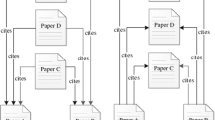Abstract
This paper proposes a simple graphical mechanism for facilitating the comparison between an author’s citation count, as measured by the Euclidean Index (Perry and Perry in Am Econ Rev 106:2722–2741, 2016), and the visibility of the journals within which an author’s articles were published, as measured by the Weighted Euclidean Index (Haley in PLoS ONE, 2019a. https://doi.org/10.1371/journal.pone.0212760). The goal is to help research review bodies easily grasp the distinction between these two forms of scholarly accomplishment and to also provide them a transparent way to articulate to scholars how the evaluation committee intends to balance these two modes of scholarly accomplishment. The robustness of the proposed composite index is also assessed.


Similar content being viewed by others
Notes
Other functional forms are, of course, possible, but the focus here is to keep the combination function simple to facilitate the exposition of the graphical depiction that follows. It is worth noting that scaling \(\hbox{AIp}_i\) by a scalar \(t \in [0,1]\) may not preserve the ranking of the composite function. It is also worth noting that the composite function values can be mirrored using another type of Weighted Euclidean Index:
$$\begin{aligned} \iota _z(\mathbf{x})\equiv \sqrt{\sum ^{n}_{i=1}z_ix^{2}_{i}}, \end{aligned}$$where \(z_i \in [0,1]~ \forall ~ i\). However, this set of weights is not unique, and, more importantly, the alternative weights \(\{z_i\}_{i=1}^n\) are complicated functions of \(\beta ,x_i,\) and \(\hbox{AIp}_i\). This casts aspersions on the usefulness of \(\iota _z(\mathbf{x})\) as an alternative representation for \(\tilde{\iota }(\mathbf{x};\beta )\).
They can also be interpreted as level curves of the bivariate \(\tilde{\iota }(\mathbf{x};\beta )\) function.
See also, Glänzel and Moed (2013).
A radius of 0.03 would induce perturbed \(\beta\) values in the [0.47, 0.53] interval.
Note that \(\iota _W(\mathbf{x})\) includes journal-based weights and all the citations. In contrast, the other extreme, \(\beta = 1\), entirely dismisses journal visibility. In this sense the generalization is inherently tipped in favor of citation-based measurement, though less so than the unweighted Euclidean Index.
References
Andersen, J. (2017). An empirical and theoretical critique of the Euclidean index. Journal of Informetrics, 11, 455–465.
Attema, A., Brouwer, A., & Van Exel, J. (2014). Your right arm for a publication in AER? Economic Inquiry, 52, 495–502.
Benito, M., & Romera, R. (2011). Improving quality assessment of composite indicators in university rankings: A case study of French and German universities of excellence. Scientometrics, 89, 153–176.
Glänzel, W., & Moed, H. (2013). Opinion paper: Thoughts and facts on bibliometric indicators. Scientometrics, 96, 381–91.
Haley, M. (2017). On the inauspicious incentives of the scholar-level h-index: An economist’s take on collusive and coercive citation. Applied Economics Letters, 24, 85–89.
Haley, M. (2019a). An EigenFactor-weighted power mean generalization of the Euclidean Index. PLoS ONE. https://doi.org/10.1371/journal.pone.0212760.
Haley, M. (2019b). A simple paradigm for augmenting the Euclidean index to reflect journal impact and visibility. Journal of the Association for Information Science and Technology. https://doi.org/10.1002/asi.24224.
Haley, M., & McGee, M. (2018). A parametric “parent metric” approach for comparing maximum-normalized journal ranking metrics. Journal of the Association for Information Science and Technology, 69, 172–176.
Haley, M., & McGee, M. (2020). Jointly valuing journal visibility and author citation count: An axiomatic approach. Journal of Informetrics (forthcoming).
Jehle, G., & Reny, P. (2011). Advanced Microeconomic Theory (3rd ed.). New York: Pearson.
Martin, B. (2013). Whither research integrity? Plagiarism, self-plagiarism and coercive citation in an age of research assessment. Research Policy, 42, 1005–1014.
Ng, Y.-K. (2017). Counting citations: Generalizing the Perry-Reny index. Journal of Informetrics, 11, 685–688.
Oswald, A. J. (2007). An examination of the reliability of prestigious scholarly journals: evidence and implications for decision‐makers. Economica, 74(293), 21–31.
Perry, M., & Reny, P. (2016). How to count citations if you must. The American Economic Review, 106, 2722–2741.
Radicchi, F., Fortunato, S., & Castellano, C. (2008). Universality of citation distributions: Toward an objective measure of scientific impact. Proceedings of the National Academy of Science USA, 105, 17268–17272.
Seeber, M., Cattaneo, M., Meoli, M., & Malighetti, P. (2019). Self-citations as strategic response to the use of metrics for career decisions. Research Policy, 48, 478–491.
Seglen, P. (1997). Why the impact factor of journals should not be used for evaluating research. British Medical Journal, 314, 498–502.
Sgroi, D., & Oswald, A. (2013). How should peer-review panels behave? The Economic Journal, 123, F255–F278.
Wilhite, A., & Fong, E. (2012). Coercive citation in academic publishing. Science, 335, 542–543.
Wilhite, A., Fong, E., & Wilhite, S. (2019). The influence of editorial decisions and the academic network on self-citations and journal impact factors. Research Policy, 48, 1513–1522.
Author information
Authors and Affiliations
Corresponding author
Additional information
The author is very grateful to David Fuller and M. Kevin McGee for helpful conversations, comments, mathematical insights, and suggestions.
Rights and permissions
About this article
Cite this article
Haley, M.R. Combining the weighted and unweighted Euclidean indices: a graphical approach. Scientometrics 123, 103–111 (2020). https://doi.org/10.1007/s11192-020-03368-x
Received:
Published:
Issue Date:
DOI: https://doi.org/10.1007/s11192-020-03368-x




